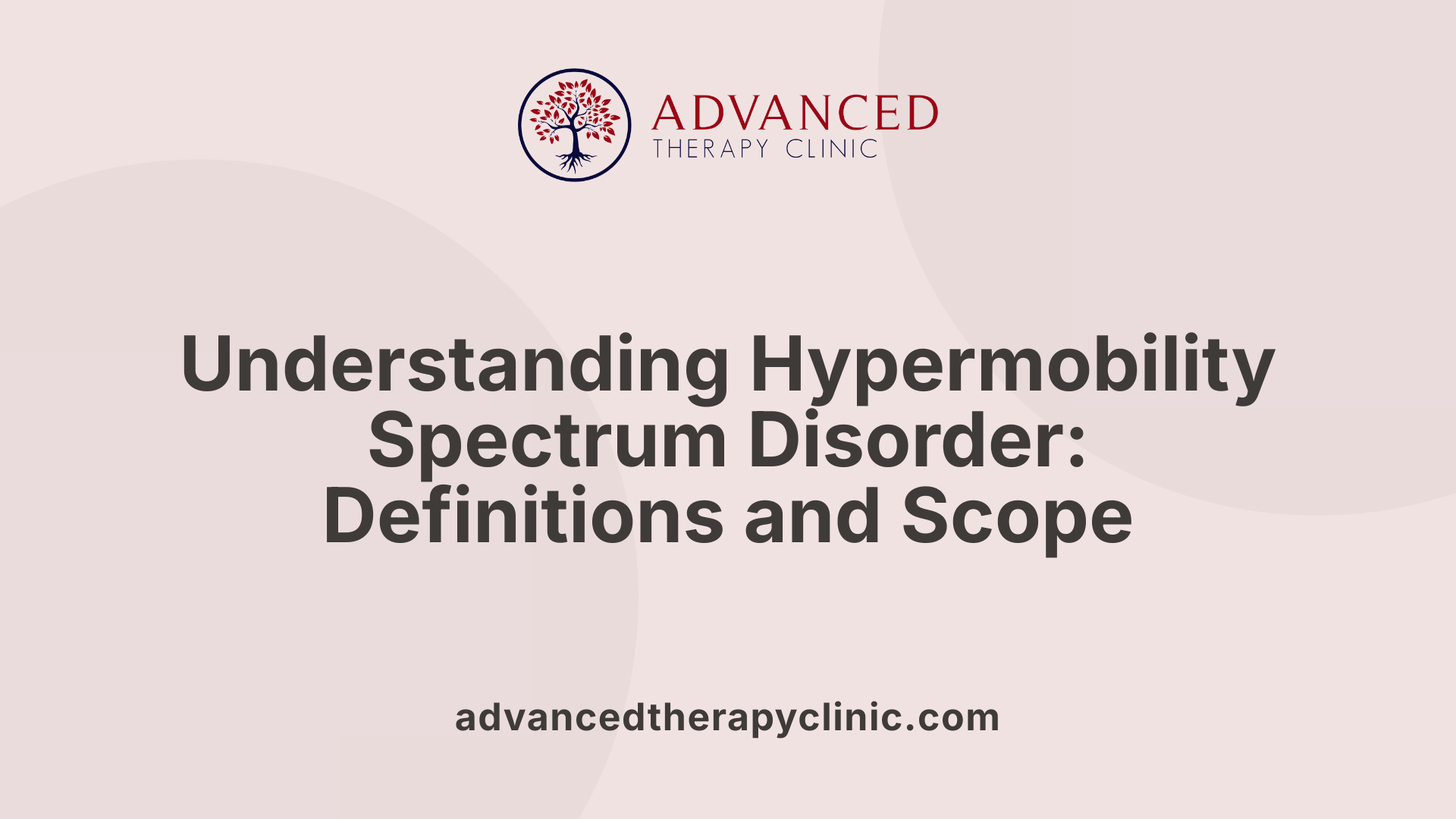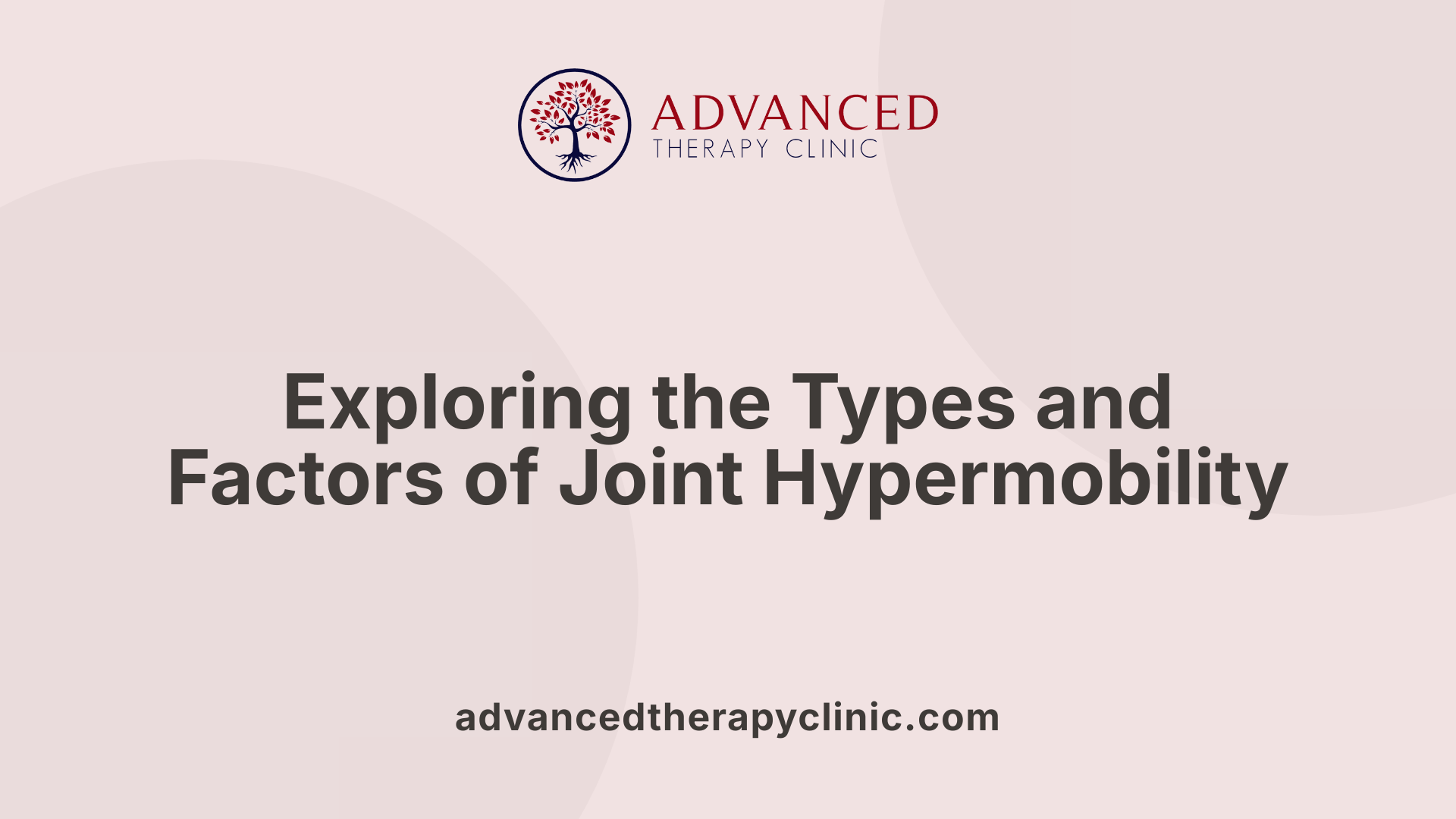What Is Hypermobility Spectrum Disorder


Introducing Hypermobility Spectrum Disorder (HSD)
Hypermobility Spectrum Disorder (HSD) encompasses a group of conditions characterized by joints that move beyond the usual range of motion, potentially causing pain, instability, and other systemic symptoms. Affecting connective tissues like ligaments and tendons, HSD requires careful diagnosis and a multidisciplinary approach to management. This article explores the nature of HSD, its symptoms, diagnosis, and comprehensive treatment strategies emphasizing the role of various therapy-related fields to improve patient outcomes.
Defining Hypermobility Spectrum Disorder and Its Scope

What is Hypermobility Spectrum Disorder (HSD)?
Hypermobility Spectrum Disorder (HSD) refers to a group of conditions where joints move beyond their normal range due to abnormalities in ligaments and tendons. This leads to hypermobile joints that can cause chronic pain, joint instability, fatigue, and various musculoskeletal symptoms.
Joints and connective tissues affected
HSD primarily affects ligaments and tendons — the connective tissues that support and stabilize joints. This results in joints that are unusually loose or flexible. The instability of these joints may cause symptoms such as joint pain, frequent joint popping, decreased joint position sense, flat feet, and easy bruising.
Distinguishing hypermobility from HSD
While hypermobility describes the ability of joints to move beyond the typical range, it does not always cause symptoms. Many people with hypermobile joints experience no issues. However, HSD is diagnosed when this joint hypermobility is accompanied by secondary musculoskeletal problems like pain, fatigue, and joint instability.
Thus, HSD represents a spectrum of conditions associated with symptomatic joint hypermobility rather than simple joint flexibility.
| Aspect | Hypermobility | Hypermobility Spectrum Disorder (HSD) |
|---|---|---|
| Definition | Increased joint range of motion | Joint hypermobility plus symptoms such as pain and instability |
| Tissue affected | Connective tissues like ligaments and tendons | Same as hypermobility but with associated musculoskeletal symptoms |
| Symptoms | Often none or mild | Chronic pain, fatigue, joint instability, bruising |
| Diagnosis | Based on physical exams like Beighton score | Based on history, exams, exclusion of other disorders |
The Range and Types of Joint Hypermobility

What are the types of hypermobility?
Hypermobility refers to the ability of joints to move beyond the normal range expected for a particular joint. This condition can be categorized into several types based on how widely it affects the body.
Localized joint hypermobility affects just a single joint or a small group of joints. In contrast, generalized joint hypermobility involves multiple joints throughout the body, often leading to broader musculoskeletal symptoms.
Other types include peripheral joint hypermobility, which typically involves the hands or feet, and historical joint hypermobility, where an individual may have had hypermobile joints in the past but no longer displays significant hypermobility.
Influence of age, gender, and ethnicity
The prevalence and presentation of hypermobility are influenced by several factors. It is more common in females than males, with studies estimating that between 10% and 25% of children display some form of hypermobility. Ethnicity also plays a role, with certain ethnic groups showing higher rates.
Age is another important consideration. Younger individuals, particularly children, are more likely to show hypermobility, which may decrease or change over time with natural aging processes impacting connective tissue flexibility and strength.
Types of hypermobility syndromes
Hypermobility can present as part of broader syndromes, such as Hypermobility Spectrum Disorders (HSDs) and Ehlers-Danlos syndromes. These conditions not only involve increased joint flexibility but also secondary symptoms like chronic pain, joint instability, and other systemic manifestations. Understanding the specific type of hypermobility helps tailor diagnosis and management approaches effectively.
Symptoms and Clinical Manifestations of HSD

What symptoms are associated with hypermobility and HSD?
Hypermobility Spectrum Disorders (HSDs) present a range of symptoms primarily involving joints but also affecting other body systems. Individuals often experience joint pain, which can be chronic and widespread. Joint instability is common, leading to frequent joint popping, subluxations, or dislocations. These symptoms contribute to difficulties with balance and frequent soft tissue injuries such as sprains or strains.
Additional symptoms include fatigue and flat feet, which affect mobility and endurance. Easy bruising reflects the underlying connective tissue fragility associated with HSD. Beyond joints, many people with HSD experience extra-articular features. These include gastrointestinal issues, such as irritable bowel symptoms, mood disorders like anxiety or depression, and dysautonomia, which involves blood pressure and heart rate irregularities.
Age influences how symptoms present. In children, hypermobility may be linked to developmental delays, altered grasp patterns, and difficulty with weight-bearing activities. Children might avoid certain motions due to pain or instability. Adolescents and young adults often report pain related to activity, decreased muscular strength, fatigue, and limitations in sports or recreational pursuits. They may also experience apprehension or reduced participation due to joint concerns.
This broad symptom profile necessitates a thorough clinical evaluation to guide effective management and optimize quality of life for those affected by HSD.
Understanding the Underlying Mechanisms of Joint Hypermobility

What causes hypermobility and HSD?
Joint hypermobility and Hypermobility Spectrum Disorders (HSDs) arise from a complex interplay of genetic and environmental factors. These influences affect the molecules and structures that provide strength and flexibility to connective tissues such as ligaments, tendons, and joint capsules.
Genetic and environmental contributions
Genetic predisposition plays a foundational role by influencing the quality and behavior of connective tissue components. Environmental factors, including physical activity, hormonal changes, and developmental history, further affect joint stability and flexibility. For example, certain hormones may modulate tissue laxity, while developmental conditions can shape joint formation.
Connective tissue components involved
The integrity of connective tissue relies largely on structural proteins like collagen and elastin. Collagen provides tensile strength, helping tissues resist stretching, while elastin allows elasticity and flexibility. In individuals with hypermobility, these proteins often exhibit altered structure or function, leading to joints that move beyond their usual range.
These tissue characteristics result in joints that are more flexible but potentially less stable, making individuals more prone to symptoms such as joint pain, instability, and soft tissue injuries commonly seen in HSDs.
| Factor | Role in Hypermobility | Additional Notes |
|---|---|---|
| Collagen | Provides tensile strength to connective tissue | Altered collagen weakens tissue stability |
| Elastin | Provides elasticity and flexibility | Excessive elasticity increases joint laxity |
| Joint capsule & ligaments | Support joints and limit movement | Laxity here contributes to hypermobility |
| Genetic predisposition | Influences connective tissue quality and repair | Can run in families and is variable by ethnicity |
| Hormones | Affect tissue flexibility | Hormonal fluctuations may increase joint looseness |
Understanding these underlying mechanisms is essential for appreciating the symptoms and therapeutic approaches related to joint hypermobility and HSDs.
Diagnostic Approach and Tools for HSD

Physical examination and medical history
Diagnosis of Hypermobility Spectrum Disorder (HSD) begins with a comprehensive medical history and physical examination. Clinicians gather information on symptoms like joint pain, instability, and musculoskeletal complaints. This clinical evaluation focuses on joint mobility and associated issues such as chronic pain, fatigue, and episodes of joint popping.
Use of Beighton scale and 5-Part Questionnaire
Two main tools support the assessment of joint hypermobility. The Beighton scale is a widely used scoring system that evaluates hypermobility in multiple joints through specific physical maneuvers, with a score of 5 or higher indicating significant hypermobility. Additionally, the 5-Part Questionnaire (5PQ) serves as a screening tool, asking patients about historical and current signs of hypermobility. Both tools complement each other to establish the presence and extent of hypermobility.
Exclusion of related connective tissue disorders
Since HSD shares features with inherited connective tissue disorders—most notably hypermobile Ehlers-Danlos syndrome (hEDS)—a diagnosis of HSD is one of exclusion. Healthcare providers perform further assessments such as imaging, genetic testing, and laboratory work to rule out these hereditary conditions. Confirming the absence of these disorders helps isolate HSD as the cause of symptoms.
Overall, the diagnostic process for HSD relies heavily on clinical judgment. It integrates detailed history taking, physical testing using validated tools like the Beighton score and 5PQ, and careful exclusion of overlapping syndromes to ensure accurate diagnosis and appropriate management.
The Importance of Physical Therapy in Managing HSD

Role of physical therapy in symptom control
Physical therapy is a cornerstone in managing Hypermobility Spectrum Disorders (HSDs). It helps alleviate common symptoms such as chronic joint pain, instability, and fatigue by focusing on strategies that enhance joint function and reduce discomfort. Through a combination of therapeutic exercises and patient education, physical therapy improves both the physical and functional aspects of daily life for individuals with HSD.
Muscle strengthening and joint stabilization
A primary goal of physical therapy in HSD management is to strengthen periarticular muscles — those surrounding the joints. Strengthening these muscles improves joint stability and helps prevent injuries. Exercises often include isometric muscle strengthening and neuromuscular training tailored to the patient's needs. Enhancing proprioception, or joint position sense, is also a key component, assisting patients in better controlling their joint movements and avoiding excessive strain.
Individualized patient care plans
Physical therapists develop personalized care plans addressing each patient's unique symptoms and lifestyle demands. These plans may incorporate balance activities, manual therapy, orthotics or bracing support, and education on activity adaptation and joint protection techniques. By targeting specific joints or activities that cause discomfort, individualized treatment enhances functional independence and quality of life. Additionally, ongoing assessment allows therapists to adjust interventions and optimize outcomes as patient needs evolve.
Specific Physical Therapy Strategies and Interventions
What is Isometric Strengthening and Neuromuscular Training?
Isometric strengthening involves muscle contractions without joint movement, building muscle support around hypermobile joints to enhance stability. Neuromuscular training focuses on improving the communication between nerves and muscles, promoting better joint control and coordination. Together, these exercises help prevent joint injuries by stabilizing joints prone to excessive movement.
How Do Balance and Proprioception Exercises Help?
Balance and proprioception exercises are designed to improve the body's awareness of joint position and movement. These activities enhance coordination, reduce the risk of falls, and support joint stability by training the sensory feedback system. Examples include balance board exercises, single-leg stands, and dynamic stability drills.
What Role Do Manual Therapy, Orthotics, Taping, and Bracing Play?
Manual therapy involves hands-on techniques to reduce pain and improve joint function. Orthotics provide support and alignment correction, especially for issues like flat feet common in hypermobility. Taping and bracing offer external stability to joints, preventing excessive movement and decreasing the chance of subluxations or dislocations.
Physical therapists personalize these interventions based on individual needs, aiming to reduce pain, improve function, and enhance quality of life in those with hypermobility spectrum disorders.
Multidisciplinary Treatment Approaches for HSD
What different therapy-related fields are commonly grouped together?
Various therapy-related disciplines are often combined to provide comprehensive care for individuals with Hypermobility Spectrum Disorders (HSD). These commonly include physical therapy, occupational therapy, speech therapy, and nutrition therapy. While physical therapy focuses on joint stability and pain reduction, occupational therapy aids patients in adapting daily activities to manage symptoms effectively. Speech therapy can address specific communication or swallowing issues, and nutrition therapy supports dietary strategies that may improve overall health and symptom management. These rehabilitation services work in concert to address the multiple functional and quality-of-life challenges presented by HSD.
How is pain managed and psychological support provided?
Pain management in HSD involves a multidisciplinary approach that includes pharmacologic treatments such as NSAIDs and acetaminophen. Additionally, psychological support is essential due to common associated mood disorders and emotional impacts. This support may incorporate counseling or therapies to manage anxiety and depression, with a focus on coping strategies for chronic pain and fatigue. Patient education also enhances understanding of the condition and self-management techniques, reducing disability and improving mental well-being.
What lifestyle adjustments and educational strategies are recommended?
Lifestyle modifications are critical in managing HSD symptoms and maintaining function. Recommendations include weight management, participation in regular low-impact exercises like swimming or cycling, and use of supportive devices such as orthotics or braces. Education is a cornerstone, with therapists providing guidance on activity pacing, joint protection principles, ergonomic modifications, and injury prevention. This holistic approach empowers patients to actively participate in their care, optimizing physical function and quality of life through informed lifestyle choices.
| Therapy Field | Primary Focus | Role in HSD Management |
|---|---|---|
| Physical Therapy | Joint stability, strengthening, pain reduction | Improves muscle support, balance, and functional mobility |
| Occupational Therapy | Adaptation of daily activities | Helps maintain independence and modifies tasks to reduce strain |
| Speech Therapy | Communication and swallowing | Addresses specific neuromuscular challenges related to HSD |
| Nutrition Therapy | Dietary and lifestyle support | Advises on nutrition to improve overall health and symptom control |
| Psychological Care | Emotional well-being and pain coping | Supports management of mood disorders and enhances coping skills |
Pain and Pharmacologic Management in HSD
What medications are commonly used to manage pain in Hypermobility Spectrum Disorders?
Pain management in Hypermobility Spectrum Disorders (HSD) often includes the use of over-the-counter analgesics such as nonsteroidal anti-inflammatory drugs (NSAIDs) and acetaminophen. These medications help reduce inflammation and alleviate mild to moderate joint and musculoskeletal pain associated with hypermobility.
How are antidepressants used in managing widespread pain in HSD?
For individuals experiencing widespread or chronic pain due to HSD, antidepressants like serotonin-norepinephrine reuptake inhibitors (SNRIs) and low-dose tricyclic antidepressants (TCAs) may be prescribed. These medications have been found to modulate pain perception and improve mood, thereby providing relief beyond traditional painkillers.
Why is opioid therapy generally avoided in HSD treatment?
Opioid analgesics are typically avoided in the management of pain related to HSD because of their high risk for dependence and limited evidence of long-term benefit. Instead, multidisciplinary approaches—primarily involving physical therapy, lifestyle changes, and safer pharmacologic options—are preferred to effectively control symptoms and improve quality of life.
Lifestyle and Self-Management Strategies
Exercise and Weight Management
Regular exercise is crucial for managing hypermobility spectrum disorders. Activities focusing on muscle strengthening, such as isometric exercises, neuromuscular training, swimming, and cycling, help improve joint stability and reduce pain. Maintaining a healthy weight also lessens joint stress, which can alleviate symptoms like fatigue and instability.
Dietary Considerations
While no specific diet cures hypermobility, adopting a balanced and nutritious eating plan supports overall health. Keeping a healthy diet can aid in weight management, indirectly benefiting joint function. Dietary strategies may also help reduce inflammation and support energy levels, contributing to better quality of life.
Activity Modification and Pacing
Modifying daily activities and pacing oneself is important to prevent injury and manage symptoms. Patients with hypermobility are encouraged to implement joint protection techniques, ergonomic adjustments, and use orthotics or supportive devices when necessary. Structured pacing allows for optimal balance between activity and rest, reducing pain and fatigue while promoting functional independence.
Challenges and Considerations in Pediatric and Adolescent HSD
Developmental Delays and Motor Skill Difficulties
Children with Hypermobility Spectrum Disorders (HSD) often face developmental delays, particularly in gross motor skills. These delays can manifest as altered grasp patterns and difficulties with weight-bearing activities. Such issues arise partly because joint instability and pain may cause children to avoid certain movements, limiting their motor development and coordination.
Age-Appropriate Therapy Adaptations
Physical therapy for pediatric and adolescent HSD patients requires age-specific modifications. Therapists focus on education about activity adaptation and joint protection techniques tailored to young patients. Exercise programs emphasize muscle strengthening and neuromuscular training to improve joint stability. Additional interventions can include orthotics or external supports, with careful attention to skin integrity in growing children.
Support for Participation in Activities
Supporting participation in sports and daily activities is a key therapy goal. Adolescents with HSD may experience pain, fatigue, decreased strength, and apprehension toward physical activity. Therapy plans incorporate activity modifications, balance training, and strengthening to encourage safe and increased participation. Engagement is fostered by addressing psychological aspects and ensuring functional independence appropriate to the patient's age and interests.
Psychological Impacts and Support Needs in HSD
Mood disorders and anxiety management
People with Hypermobility Spectrum Disorders (HSD) often face psychological challenges including mood disorders and anxiety. These symptoms may arise as a response to chronic pain, physical limitations, and the unpredictability of joint instability. Managing these mood and anxiety issues is crucial to improving overall quality of life for individuals with HSD.
Importance of psychological therapies
Psychological therapies, such as cognitive-behavioral therapy (CBT) and emerging tailored psychological interventions, play a vital role in the multidisciplinary treatment approach for HSD. Addressing mental health alongside physical symptoms helps break the cycle of pain-related anxiety and fatigue. Research supports including psychological support to aid coping, reduce anxiety, and improve compliance with physical rehabilitation.
Integration with physical rehabilitation
Integrating psychological therapies with physical rehabilitation ensures a holistic treatment plan. Physical therapy for HSD focuses on joint stability, strength, and function, while psychological support addresses emotional well-being. This combined care contributes to better treatment adherence, enhanced functional outcomes, and patient empowerment, creating personalized care plans that support both body and mind.
Research and Emerging Trends in HSD Treatment
What evidence supports physical therapy interventions for HSD?
Physical therapy (PT) is widely recognized as a cornerstone in treating Hypermobility Spectrum Disorders (HSDs), particularly Generalized HSD (G-HSD) and hypermobile Ehlers-Danlos Syndrome (hEDS). Therapeutic exercise and motor function training have the strongest evidence backing their effectiveness in improving joint stability, reducing pain, and enhancing function. These interventions include muscle strengthening—especially isometric exercises—and neuromuscular training aimed at improving proprioception and balance.
While other PT modalities such as manual therapy, adaptive equipment, functional training, and patient instruction are used in practice, current research offers only weak evidence regarding their independent effectiveness. Despite this, these interventions can still play a supportive role within comprehensive care plans.
Why is multidisciplinary and personalized care important for HSD management?
HSDs present with diverse symptoms that extend beyond joint hypermobility, including fatigue, pain, dysautonomia, gastrointestinal issues, and mood disorders. This complexity necessitates a multidisciplinary approach involving physical therapy, occupational therapy, pharmacological management, psychological support, and lifestyle modifications.
Personalized care plans tailored to the individual’s symptom profile, activity levels, age, and functional goals are essential. Physical therapists often develop customized programs that integrate strengthening exercises, joint protection strategies, balance activities, and patient education to optimize outcomes and prevent injury.
What are the ongoing research efforts and future directions in HSD treatment?
Current research emphasizes the need for rigorous studies to establish the optimal types and dosages of PT interventions for HSDs. There is growing interest in understanding the psychological impact of hypermobility and integrating mental health care with physical rehabilitation.
Moreover, explorations of novel therapeutic approaches—such as new motor training techniques, targeted exercise protocols, and integrative therapies—are underway. Future research aims to clarify the long-term benefits of multidisciplinary care and develop standardized treatment guidelines to improve quality of life for individuals living with HSDs.
Living with Hypermobility Spectrum Disorder: Quality of Life Considerations
Workplace and lifestyle adjustments
Living with Hypermobility Spectrum Disorder (HSD) often requires thoughtful changes in daily activities and work routines. Many individuals face challenges due to joint pain, fatigue, and instability, which can hinder their ability to perform certain tasks. Ergonomic modifications, pacing activities, and using supportive devices like braces or orthotics help reduce strain on joints and prevent injury. Employing these adjustments can make work environments more accommodating and reduce discomfort during daily activities.
Sleep and pregnancy-related issues
Sleep disturbances are common among people with HSD, often due to chronic pain and discomfort experienced at night. Proper pain management and comfortable bedding to support joints are important strategies. Pregnancy may also pose unique challenges, as increased joint laxity during this time can exacerbate symptoms. Close monitoring by healthcare providers and tailored physical therapy can help manage symptoms to maintain maternal health and comfort throughout pregnancy.
Patient education and empowerment
Educating patients about their condition is essential to improve self-management and quality of life. Understanding the nature of HSD, recognizing early signs of joint instability, and learning joint protection techniques empower individuals to make informed choices. Physical therapists often provide personalized care plans, including exercises for muscle strengthening and balance improvement, which are crucial to maintaining joint stability. Encouragement to engage in appropriate physical activities and lifestyle modifications supports long-term health and functional independence.
Bringing It All Together: Managing Hypermobility Spectrum Disorder
Hypermobility Spectrum Disorder presents a complex interplay of joint hypermobility and associated symptoms that require a comprehensive, individualized approach for effective management. Diagnosis hinges on clinical evaluation supported by standardized assessment tools, while treatment benefits greatly from multidisciplinary collaboration—integrating physical therapy, occupational therapy, psychological support, and lifestyle modifications. Advancements in research continue to refine therapeutic strategies, emphasizing the importance of patient education, tailored exercise programs, and ongoing support to improve stability, reduce pain, and enhance overall quality of life for those affected by HSD.
References
- Physical Therapy Guide to Hypermobility Spectrum ...
- Hypermobility spectrum disorders: A review - PMC
- Hypermobility
- Joint Hypermobility Syndromes: Assessment and Intervention
- Joint hypermobility | Causes, symptoms, treatments
- Physical therapy interventions in generalized hypermobility ...
- Types of Mental Health Professionals
Recent articles

Expressive Speech Delay 2-Year-Old
Understanding and Addressing Expressive Speech Delay in Toddlers

How Speech Recognition Works
Unlocking the Power of Speech Recognition in Therapy and Healthcare

Autism and Head Size
Understanding the Complex Relationship Between Autism and Head Size

Occupational Therapy in Autism
Enhancing Independence and Quality of Life Through Occupational Therapy in Autism

Do Autistic People Understand Sarcasm?
Navigating the Nuances: Understanding Sarcasm and Social Communication in Autism

Autism Routines
Crafting Effective Daily Structures for Children with Autism


